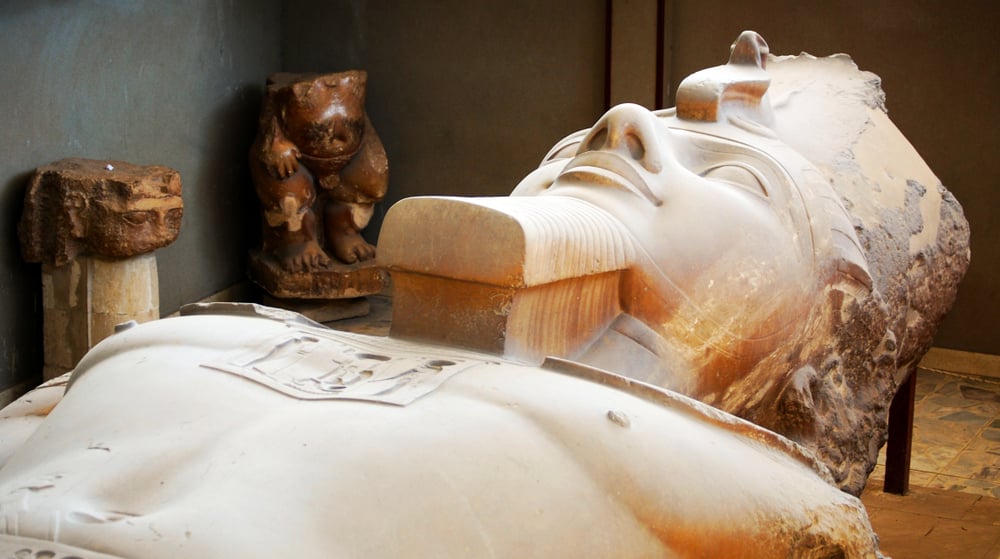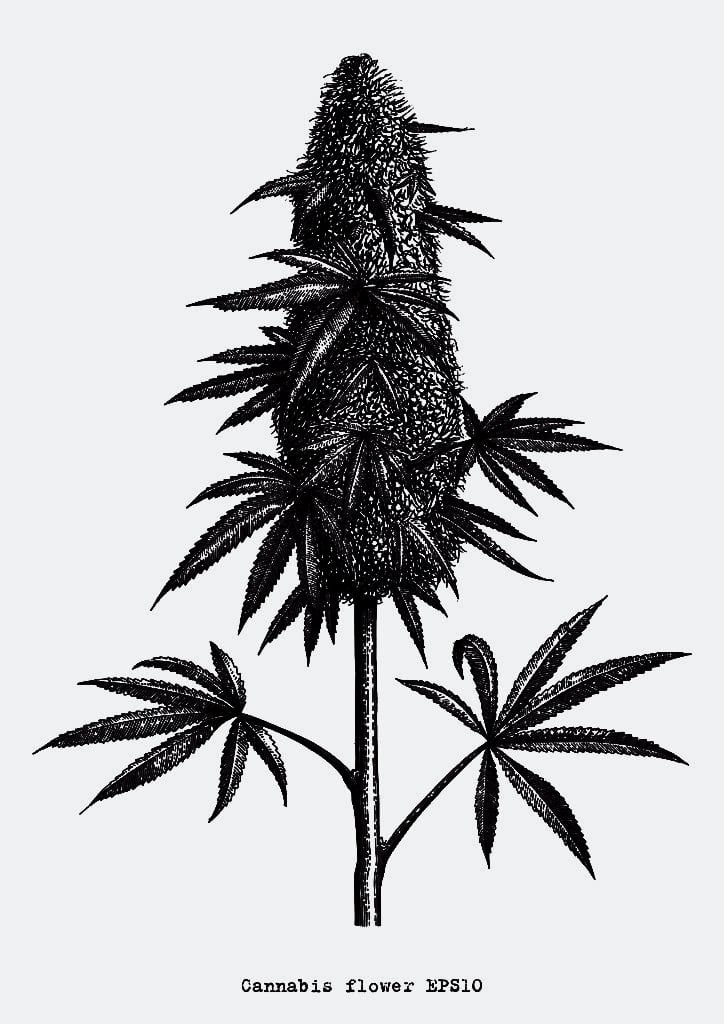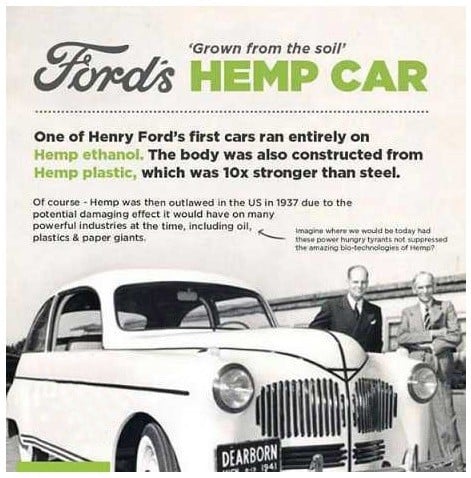Hemp was one of the first agricultural crops grown by humankind over 10,000 years ago. Archaeologists found Egyptian mummies buried with cannabis plants, including Pharaoh Ramses II. Hemp was so revered in the ancient world that scientists unearthed a 2,400-year-old body that had been ceremonially covered in a hemp shroud.
It’s no wonder that hemp had been seen as such a sacred plant by ancient cultures. Most experts agree that hemp has more than 25,000 different uses. Some even claim that the number of industrial uses is as high as 50,000.
Throughout history, hemp was such a valuable resource that governments created laws advocating hemp production. In the 1600s, England mandated that early American colonists try growing “Indian Hemp.” Several of America’s Founding Fathers, including George Washington and Thomas Jefferson, cultivated the plant. Jefferson was one of the world’s first hemp activists. He registered the patent for the first hemp thresher and encouraged farmers to grow hemp instead of tobacco.
Why was hemp so important to early human civilization? What was it used for, and why have we forgotten the many uses of hemp? Let’s explore these questions and find out more about the amazing history of hemp and the marijuana plant.
What is Hemp?
Hemp is a dioecious plant that belongs to the genetic family, Cannabaceae. The hops we use to make beer belong to the same family. But what exactly is the difference between hemp vs marijuana?
Scientists generally break cannabis plants into three species: Cannabis sativa, Cannabis indica, and Cannabis ruderalis.
Cannabis sativa tends to grow tall with widely-spaced nodes and thin fan leaves. Sativa-dominant hemp hybrids are known for their energetic effects. Cannabis indica produces short, bushy plants with broader leaves. Consumers generally associate indica-dominant hemp varieties with physical relaxation and less psychoactive effect. Cannabis ruderalis plants are native to harsh environments throughout Eastern Europe and Russia. The short ruderalis plants produce extremely low amounts of cannabinoids and aren’t particularly useful for therapeutic or industrial purposes. However, some hemp breeders use ruderalis plants for breeding auto-flowering hybrids.
Hemp plants are a subspecies of the Cannabis sativa lineage called Cannabis sativa L. Hemp plants tend to grow tall and have particularly fibrous stalks and stems, making them ideal for industrial purposes.
The legal definition of industrial hemp in the United States includes Cannabis sativa plants that contain less than .3% delta-9 tetrahydrocannabinol (THC). The United Kingdom lowers the limit to .2% THC level.
What is Hemp Used for Today?
Before the 2018 Farm Bill removed hemp from the controlled substances list, hemp had been relegated to health food stores and specialty shops in the form of nutritional supplements. Hemp seeds and hemp oil contain high amounts of protein, fiber, and vitamins and minerals, such as antioxidants and omega-3 fatty acids. The first evidence of humans consuming hemp food products in the west came from an excavation of Pompeii. Archaeologists found carbonized hemp seeds dating back to the eruption of Mount Vesuvius in 79 A.D. Hemp protein is also used as a replacement for whey protein.
One of the primary uses of hemp today is for CBD products. Although people smoked hemp for enjoyment in the past, modern industrial hemp flowers were largely disregarded for their lack of THC. Advances in cannabis medicine now show that hemp flowers are rich in other useful cannabinoids such as cannabidiol (CBD), cannabigerol (CBG), and cannabimovone (CBM). Hemp breeders have successfully created strains featuring alternative cannabinoids, such as Cannaflower’s White CBG.
The passing of the 2018 Agricultural Act has also sparked a resurgence of the hemp industry.
What is Hemp Used for Medically?
Cannabis had been used in ancient Chinese medicine from at least 2,700 B.C. when Emperor Shen Neng wrote about its use in treatments. Traditional Chinese Medicine (TCM) includes a host of cannabis-based remedies, including non-intoxicating cannabis stem tea, which has no THC content. Indian Ayurvedic medical texts document the therapeutic use of cannabis from as early as 1100 B.C. The Ebers Papyrus is an ancient scroll that documented Egyptian medical remedies, including cannabis.
Cannabis medicines were used widely until the early 1900s. The United States’ pharmacopeia included cannabis medicines from 1854-1942. Cannabis-based tinctures reportedly provided relief from conditions ranging from arthritis and respiratory issues to gonorrhea and rabies. Some of the most respected names in the pharmaceutical industry at the time manufactured medicines containing cannabis, including:
- Ely Lilly
- Bristol-Meyers
- Smith-Davis
- Merck
- Parke-Davis
In the 1920s, cannabis cigarettes were popular asthma treatments. Rumor has it that Queen Victoria used cannabis to ease menstrual pain. Despite the inclusion of cannabis and hemp as Schedule I drugs with “no medicinal value,” the U.S. government has run a program that gave patients cannabis since 1978.
More recently, the FDA has approved four cannabis-derived medications: Marinol, Epidiolex, Syndros, and Cesamet. Modern medical uses of cannabis and hemp-based medications include:

- Epilepsy: CBD’s usefulness in treating seizures has become world-famous through the success stories of epileptic children, such as Charlotte Figi.
- MS: Medical cannabis doctors often recommend cannabis and hemp-derived products to reduce the muscle spasms experienced by patients with multiple sclerosis.
- Glaucoma: Compounds in cannabis decrease the intraocular pressure associated with eye diseases like glaucoma.
- Cancer: Research found that cannabidiol can cause selective apoptosis of breast cancer cells. CBD oil and cannabis have also been successfully used to relieve chemotherapy symptoms such as nausea and lack of appetite.
- AIDs: In the early 1980s, the AIDs epidemic sparked California’s medical cannabis movement. Activists like Brownie Mary and Dennis Peron supplied cannabis to people struggling with AIDs and cancer and fought for legalization.
Today, since the focus has shifted from psychoactive THC to CBD, medical researchers have found an abundance of potential uses for cannabis plants, especially high-CBD hemp plants. Scientists have found that CBD interacts with the endocannabinoid system (ECS) to help the body balance vital functions, such as:
- Sleep cycles
- Inflammation
- Mood regulation
- Temperature control
- Fertility
5 Uses of Hemp Products We’ve Forgotten About
Making Textiles
Humans have manufactured hemp fabrics for thousands of years. Our evidence of hemp textiles dates back to 8,000 B.C. Archaeologists found a fragment of hemp cloth in a site from ancient Mesopotamia. The original blue jeans, manufactured by Levi Strauss and Company, were fashioned from recycled hemp.
Hemp textiles weren’t limited to clothing. Early American pioneer wagons used hemp canvas coverings. The word “canvas” comes from an ancient Sumerian term meaning “cannabis.” The first American ships also relied on hemp cloth for sails. The legendary ship, Old Ironsides, used over 60 tons of hemp for its canvas sails and rope rigging. The first U.S. military also employed hemp for soldier’s uniforms.
Susan B. Anthony fashioned the first American flag out of hemp cloth. Several of Rembrandt and Van Gogh’s iconic paintings were painted on hemp canvas using hemp-based oil paints.
Hemp cloth has several distinct advantages over cotton. It takes 2-3 times as much land to cultivate cotton as it does hemp. Cotton accounts for around 50% of the world’s pesticides and herbicides. Hemp clothing typically lasts twice as long as cotton garments. Over time, hemp textiles get softer but not weaker.
Making Paper
Many cultures have used hemp for paper for over 2000 years. Hemp paper was found in Chinese tombs dating to as early as 140 B.C. Some of the world’s most famous documents were written on hemp paper, such as:
- Both the 15th-century Gutenberg Bible and the 17th-century King James Bible were written on hemp.
- The Founding Fathers wrote and signed the “Declaration of Independence” using hemp paper.
- The Encyclopaedia Britannica was printed on hemp paper for over 150 years.
- Lewis Carroll’s original Alice’s Adventures in Wonderland debuted on hemp paper.
It wasn’t until the 20th century that wood pulp replaced hemp paper. Hemp plants can grow up to four meters in only four months and require minimal fertilizers.
Hemp needs less water and fewer chemicals to grow than wood pulp paper. Paper made from wood pulp requires harsh chemicals for bleaching. In contrast, manufacturers can bleach hemp paper using non-toxic hydrogen peroxide.
Hemp agriculture benefits the environment in many ways. Hemp’s carbon dioxide consumption is five times greater than most trees, making the plant a valuable resource in cleaning our air. Bees use hemp flowers as an alternate food source in times of scarcity. A study conducted by Colorado University discovered at least 23 bee species in the state’s hemp fields. Without bees to pollinate plants, over 100 agricultural crops couldn’t survive, including apples, almonds, and broccoli. According to the American Beekeeping Federation, bees contribute $20 billion per year to the U.S. Agricultural Industry.
Additionally, hemp is one of the most efficient crops to use for bioremediation of soil. Hemp plants have a pronounced ability to extract chemicals, heavy metals, and radiation from damaged land. Scientists have successfully used hemp to clean up the soil around Chernobyl. Unfortunately, Japan’s strict laws prohibiting cannabis and hemp cultivation have barred hemp from being used to clean up after the accident in Fukushima.
Making Rope
Hemp rope-making dates as far back as 10,000 B.C. The excavation of a neolithic site in Taiwan found a ceramic pot with a hemp cord attached. An ancient Egyptian text describing the construction of the pyramids around 3,500 B.C. depict the use of hemp for rope. The text remarks about the strength and effectiveness of the hemp rope. In 200 B.C., the Greek tyrant Hiero II used hemp rope for his ships and commented on hemp’s superiority over other contemporary rope-making fibers.
Hemp rope has distinct advantages over other materials. First, hemp is stronger because it has longer fibers. Other rope materials, such as cotton, only have fibers that reach up to an inch or so, while hemp fiber can be more than a foot long. Additionally, hemp rope is almost impervious to rot.
Recognizing the need for hemp rope, the United States government temporarily relaxed the hemp regulations during WWII. Both the Allies and Axis powers recognized the importance of hemp for the war effort. Nazi Germany had established its own hemp production, and the U.S. was at a disadvantage for having outlawed hemp production. As an attempt to level the playing field, the U.S. government urged farmers to cultivate hemp with the wartime propaganda film, “Hemp for Victory .” The government also sent seeds to farmers to encourage them to grow hemp crops.
On a smaller scale, hemp twine is a favorite material for artisans who make items like jewelry, belts, and handbags. Hemp macrame has been popular since the late 1960s. Today, hemp twine comes in a wide array of colors and thicknesses. Manufacturers even offer soft hemp yarn to use for knitting, crocheting, and weaving.

Making Sustainable Building Materials
As more and more people recognize the importance of environmental sustainability, hemp is catching on as a building material. Hemp construction is nothing new. As early as the 6th century, the Merovingians and Romans fortified their buildings and bridge abutments with hemp fibers.
Modern hempcrete is a combination of lime, water, and the woody inner core of hemp plants, which is called the “hurd” or “shiv.” While hemp houses must still be framed, solid hempcrete replaces the need for insulation. Building with hempcrete is similar to Native American adobe or European cobb construction. Modern solid-wall construction in places like Latin America uses concrete, which is geothermally inefficient and has a negative effect on the environment.
Hempcrete has several distinct advantages over conventional building materials, including:
- Lightweight
- Thermally efficient
- Resistant to mold and insects
- Fire resistant
- Environmentally friendly
In 2010, engineers constructed the first modern hemp house in North Carolina. The first modern hemp constructions couldn’t use hempcrete for support beams or load-bearing walls. Recently, architects and engineers in Canada have developed a hemp-based block with a compressive strength of more than 5,800 psi, making it suitable for load-bearing wall construction.
Hemp can also replace petrochemicals for making bioplastics, and unlike plastics made from fossil fuels, hemp is biodegradable. An article published in the February 1938 edition of Popular Mechanics magazine called hemp the “New Million Dollar Crop.” The article outlined the plant’s diverse industrial uses as raw material and talked about a new machine, the decorticator, that would make separating the fiber from the woody stem more efficient. Unfortunately, the article had come out too late. After the passing of the Marihuana Tax Act of 1937 by the federal government, industry infrastructure began to concentrate on petroleum-based products.
In 1941, automobile manufacturer, Henry Ford, built a car entirely from hemp. The car’s body reportedly was ten times stronger than steel. Ford understood both the economic and environmental advantages of manufacturing with hemp. During the unveiling, Ford remarked, “Why use up the forests, which were centuries in the making, and the mines, which required ages to lay down, if we can get the equivalent in forest and mineral products in the annual growth of the hemp fields?”
Unfortunately, Henry Ford abandoned the idea of manufacturing hemp cars due to pressure from the steel and petroleum industry.
The hemp renaissance is placing hemp auto manufacturing in the spotlight again. In 2019, Porsche started shipping its Cayman GT4 sports car featuring a hemp body and other hemp-based components. A Canadian company called ehBus is currently working on an electric bus made almost entirely of hemp materials. The company is crowdfunding the project and plans to make the bus run on solar and wind energy.
Alternative Fuel
Modern society is so utterly dependent upon petroleum products that we’ve forgotten one of the cleanest fuels in history—hemp. Before the advent of electricity, people used hemp oil lanterns for indoor lighting. Ford’s ground-breaking hemp car ran on hemp biodiesel.
Researchers estimate that hemp can produce 800 liters of biodiesel per hectare per year, making hemp more productive than other biofuel crops, such as soybean or sunflower oil. Hemp seeds contain up to 30% oil, which can be converted into clean-burning ethanol through a process called transesterification. But it’s not just the seeds that manufacturers can use to produce fuel. The entire hemp plant can be converted to an ethanol product that meets all standards for biodiesel quality. Hemp biofuel fulfills the rigorous testing parameters of both the American Society for Testing and Materials (ASTMD6751) and the European Committee for Standardization (EN14214).
Hemp can also be transformed into a cleaner solid fuel that has the potential to replace coal. Hemp has the capacity to produce a biomass energy yield of 150% higher than the wheat straw typically used to make solid fuel pellets. The implications for the use of hemp solid fuel is staggering. Homes would no longer need to use precious trees for firewood, and industry could phase out coal and other fossil fuels.
***
Hopefully, the hemp renaissance will help us recover the forgotten treasures available from this remarkable plant. If we can embrace the many uses of the hemp plant, we can revolutionize the way we interact with the natural world and solve some of the planet’s most pressing environmental issues.
Explore Our Menu!
The world’s best CBD hemp flower straight to your door.
__________________
Resources
- Romey, K. (2016) “Ancient Cannabis ‘Burial Shroud’ Found in Desert Oasis.” National Geographic Magazine.
- Herer, J. (1985) The Emperor Wears No Clothes. Van Nuys, CA: A Ha Publishing.
- Mount Vernon Staff. (2020) “Did George Washington Grow Hemp?” George Washington’s Mount Vernon.
- Monticello Staff. (2020) “Hemp.” Thomas Jefferson Encyclopedia.
- Rep. Conaway, K. (2018) “Agricultural Improvement Act of 2018.” United States Congress.
- Meyer, F. (1980) “Carbonized Food Plants of Pompeii, Herculaneum, and the Villa at Torre Annunziata.” Economic Botany.
- Bridgeman, M. (2017) Medicinal Cannabis: History, Pharmacology, and Implications for the Acute Care Setting.” Pharmacy and Therapeutics.
- Blake, A. (2016) “History of Medical Cannabis.” Medical Cannabis Project.
- Hall, W. (2015) “U.S. Policy Responses to Calls for the Medical Use of Cannabis.” Yale Journal of Biology and Medicine.
- FDA staff. (2020) “FDA and Cannabis: Research and Drug Approval Process.” U.S. Food and Drug Administration.
- Tomida, I. (2004) “Cannabinoids and Glaucoma.” British Journal of Ophthalmology.
- Shrivastava, A. (2011) “Cannabidiol Reduces Programmed Cell Death in Breast Cancer Cells…” Molecular Cancer Therapeutics.
- The Thistle staff. (2000) “The People’s History.” The Thistle: MIT University Press.
- Gibson, K. (2008) “Hemp Paper: 2,000 Years On.” Journal of Industrial Hemp, Vol. 12.
- Shea, A. (2012) “Hygrothermal Performance of an Experimental Hemp Lime Building.” Construction and Building Materials, Vol. 36.
- Wilson, C. (2018) “The Future for Hemp.” European Industrial Hemp Association.
- O’Brien, C. (2018) “What’s with All the Buzzing?: Exploring Bee Diversity in Industrial Hemp.” Entomology: Colorado State University.
- American Beekeeping Federation (2020) “Bees are Pollinators.” New Agriculturist.
- Cornell University Staff. (2009) “Bioremediation.” Environmental Inquiry.
- Ministry of Hemp. (2018) “Hemp Remediation: The Miracle Crop That Actually Cleans Soil.” Ministry of Hemp Medium Blog. Medium.
- The History of Cannabis Museum. (2020) “8000 B.C. (Ancient Taiwan).” History of Cannabis Museum.
- Attia, V. (2017) “Cannabis (Marijuana-Hemp) in Ancient Egypt.” Academia.edu.
- Lahanas, M. (2020) “The Syracusia Ship.” Hellenic World.
- United States Department of Agriculture. (1942) “Hemp for Victory.”: Library of Congress.
- Souza, E. (2020) “Hemp Concrete: From Roman Bridges to a Possible Material of the Future.” ArchDaily.
- Pepescu, A. (2018) “There’s No Place Like Home, Especially if It’s Made of Hemp.” The New York Times.
- Brownell, B. (2018) “Dazed and … Constructed? How Hemp Could Alter Material Selections in Architecture.” Journal of the American Institute of Architects.
- Popular Mechanics. (1938) “New Million Dollar Crop.” Popular Mechanics.
- Solomon, D. (1937) “The Marihuana Tax Act of 1937.” Schaffer Library of Drug Policy.
- Plumb, C. (1941) “Henry Ford’s Hemp Car.” Very Magazine.
- Negron, J. (2015) “Hemp (Cannabis sativa L.) Should Be Legal or Illegal?” Writings and Thoughts of One Same Being. Wordpress.
- Reid, A. (2019) “This Race-Spec Porsche Boasts 425 HP—and a Body Made of Hemp.” Driving magazine.
- Alcheick, A. (2015) “Advances and Challenges of Hemp Biodiesel Production.” Faculty of Engineering and Sustainable Development: University of Gayle.
- Baskar, G. (2019) “Advances in Eco-Fuels for a Sustainable Environment.” Advanced Biofuels.
- ASTM Subcommittee. (2020) “Standard Specification for Biodiesel Fuel Blend Stock for Middle Distillate Fuels.” ASTM International.
- Prade, T. (2011) “Biomass and Energy Yield of Industrial Hemp Grown for Biogas and Solid Fuel.” Biomass and Bioenergy, Vol. 35.







